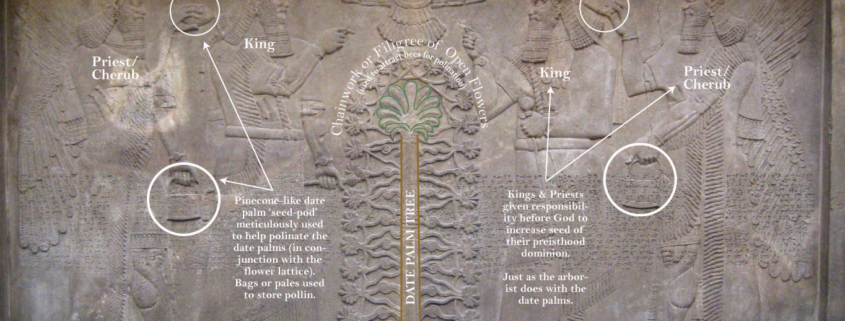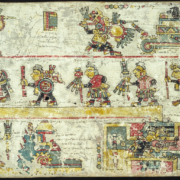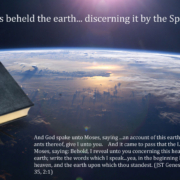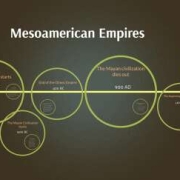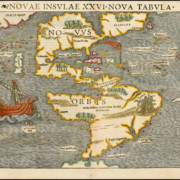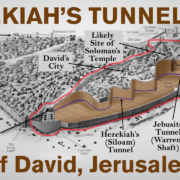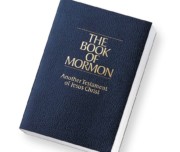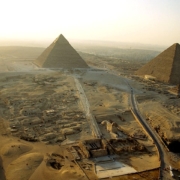The Reliefs of Dur-Sharrukin as Plunder from Solomon’s Temple
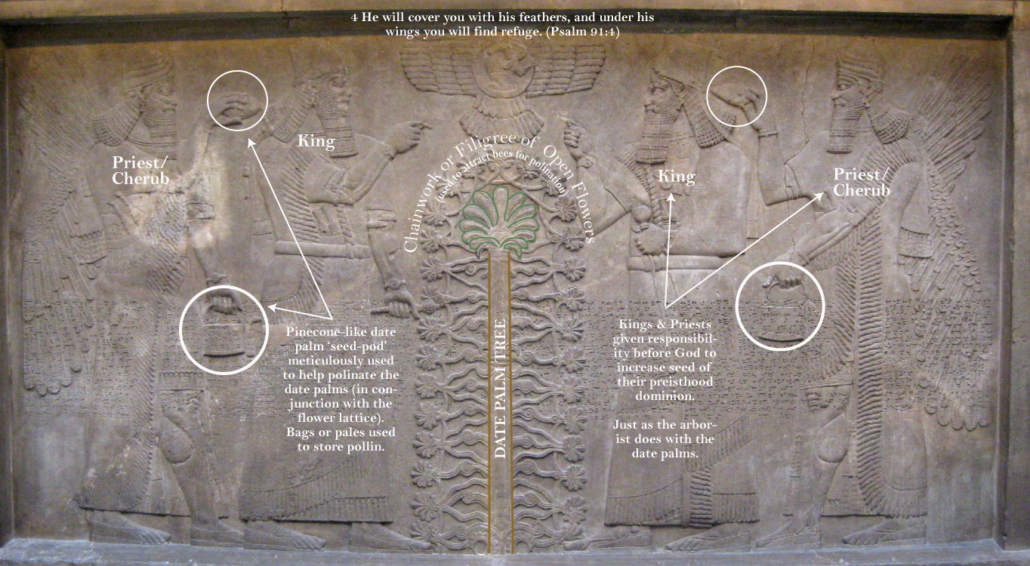
Background
The following information came to me in a dream. I was awoken early in the morning to a voice in my head not unlike other experiences I have had from time to time when working on religious research or scripture/archaeological correlations. This voice spoke with me about the eagle and handbag motif I had recently been studying from the Assyrian temple compound of Dur-Sharrukin and its relationship to the Mesoamerican site of La Venta’s bird masked relief with a similar hand bag. After tracking the similarities between these reliefs and the temple rites found in the Kolbrin, I began assuming these were somehow related to the Northern Kingdom of Israel. Because the Assyrian reliefs date to around 720 BC, my assumption was that King Ahaz or some other Northern Kingdom monarch had spread his cultural ideas into Assyria some time before 720 BC. However, the angelic voice told me “No! These reliefs are from the Jerusalem temple and are related to Daniel.” As has been the case in other similar occasions, my mind seemed linked with a higher intelligent and I could ‘see’ everything I was being told clearly, all of it making perfect sense.

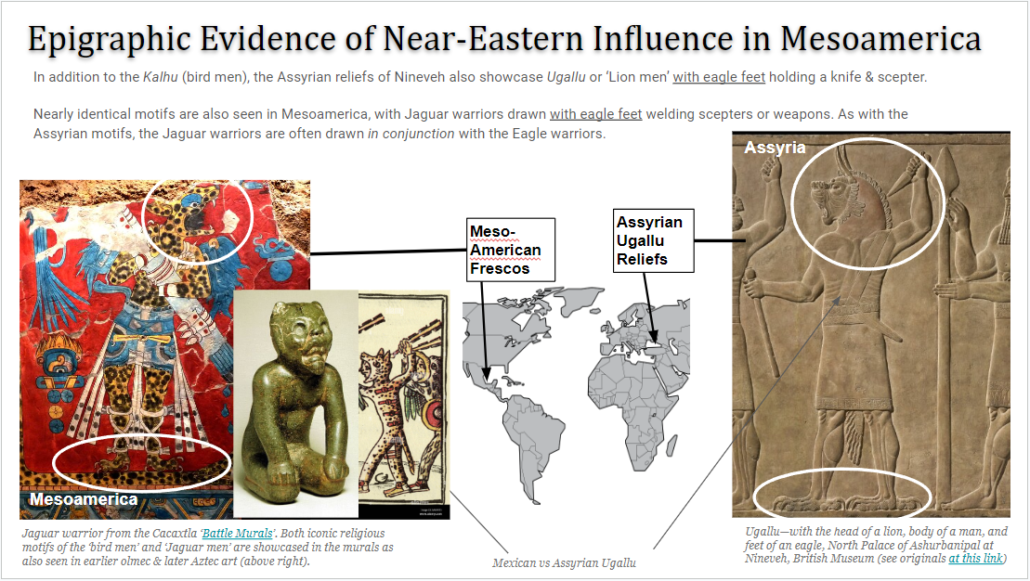
However, when I woke up and began thinking about this I quickly dismissed it because of many issues that just didn’t line up for me. The timing was wrong with it predating the Babylonian destruction by around 120 years. The location was wrong, because it was way too far north in Assyrian territory, and not down by the delta where most believe Babylon was. And most of all, it seemed impossible that Israel would have reliefs of animals that seemed so idolatrous to me in the temple compound. However, there were scriptures from Ezekiel and Isaiah in my mind from the visionary dream, which later in the day I decided to look up.
One after another, as I read the scriptures that talked about the temple, I was blown away. They matched NEARLY PERFECTLY with what I learned in the dream. But even then, I just could not get past the stumbling blocks of the location and date. However, as I continued to research on the source for the dates of this site, as well as the Assyrian king names I began to see how they could be misidentified and misdated. The most significant of these being the idea shown below of Nebuchadnezzar’s Babylonian Hanging Gardens actually being the Assyrian city of Nineveh. I still haven’t worked out the details, but it appears possible that Nebuchadnezzar II (or an earlier of his dynasty), conquered these Assyrian cities and made them his northern capital (with a secondary capital down near the traditional sites near the Delta). And that this could be why archaeologist have not found Nebuchadnezzar’s Babylonian garden tower, palace or evidence of him conquering Egypt or Jerusalem or much evidence for the Jedeo-Babylonian captivity. Because they have misattributed the Babylonian evidence to Assyrian kings. Below is a ‘work in progress’ article on the results of my research stemming from my dream.
Introduction
Has the artwork of Solomon’s temple been lost in plain sight for 200 years? The artwork at the top of the page comes from the archaeological site of Dur-Sharrukin near the village of Khorsabad in northern Iraq.
Lost to history in antiquity, the site was first excavated in 1843 by Henry Layard… (finish into)
So how did archaeologists confuse the Nebuchadnezzar II famous city of Babylon which housed Daniel and the deported Jews with the Assyrian city of Nimrud? Renowned Assyriologist Stephanie Dalley has essentially worked that out in her groundbreaking book “The Mystery of the Hanging Garden of Babylon: An Elusive World Wonder Traced.” In it, she theorizes that the accounts Nebuchadnezzar II Hanging Gardens of Babylon might actually be the Great Ziggurat found in Nineveh. (flesh this out)

However, I believe that all her evidence and reasoning actually also works in reverse. Instead of her reasoning that archaeologists are right and Greco-Roman historians are wrong concerning the identity of the city with the Hanging Gardens, it is just as possible that the Greco-Roman historians are right and the archaeologists are wrong in where they think the hanging gardens should be! Perhaps instead, Nebuchadnezzar II actually had TWO palaces, one in the southern delta near Bagdad, and another northern capital where he reoccupied the conquered Assyrian cities near Mosul. And it is THIS northern capital of Babylon (Old Nineveh) where he built his hanging gardens, deported the Jews to, and adorned it with all the hundreds of stolen panels from the Jerusalem temple! These panels were then taken by Nebuchadnezzar II’s two successors and used to decorate their palaces as well (Nimrud & Dur-Sharrukin). [reference a more detailed description below]
This is why Stephanie Dalley found that the tombs of Nimrud contained Hebrew queens, likely from the kingdom of Judah instead of Samarian queens from Northern Israel. (see the rest of her exhaustive evidence in her book)
In addition to the Hebrew Queens Tombs, substantial evidence for this theory also exists in the Nimrud Ivories. This stash of thousands of small ivory carvings are known to have originated almost exclusively from the Levant (Israel) and Egypt. In addition to the obvious foreign artwork they also contain numerous Phoenician and proto-Hebrew inscriptions, along with an overwhelming number of motifs which tie supposed Assyrian Wall Relief artwork to Egypt and Israel. By looking through the thousands of images, one can see the evolution of the motifs from their Egyptian roots into the more “Assyrian” (Israeli) motifs seen in the wall panels. (see whitepapers here & here)
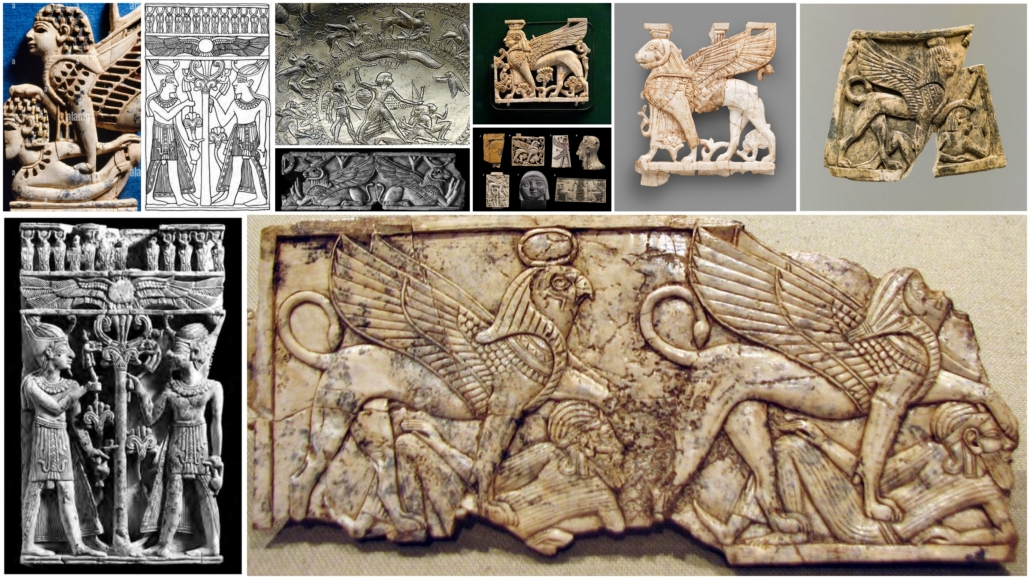
Just as parts of the Nimrud Ivories are clearly from Phoenicia, the Levant (Israel) and Egypt, The wall reliefs of Nimrod and Dur-Sharrukin seem to have motifs straight out of the Jewish biblical record. They also bare striking resemblance to many earlier Assyrian, Babylonian, Hittite and Urartian art pieces dating from the sixth to tenth centuries. It seems logical from the biblical evidence I’m about to present, that the biblical artwork and religious motifs mentioned below were part of a regional cultural tradition which stretched from Israel into Babylon, Assyria, Turkey, Persia and even Armenia. This also fits into the biblical record where Biblical kings David & Saul conquered territory stretching to the Euphrates river and presumably allowed Israelite peoples to immigrate northward into Syria & Turkey from as early as 1000 BC. Elsewhere I make a case for the aggressive spread of this same religious iconography & culture into areas of the New World through the ancient port city of La Venta.
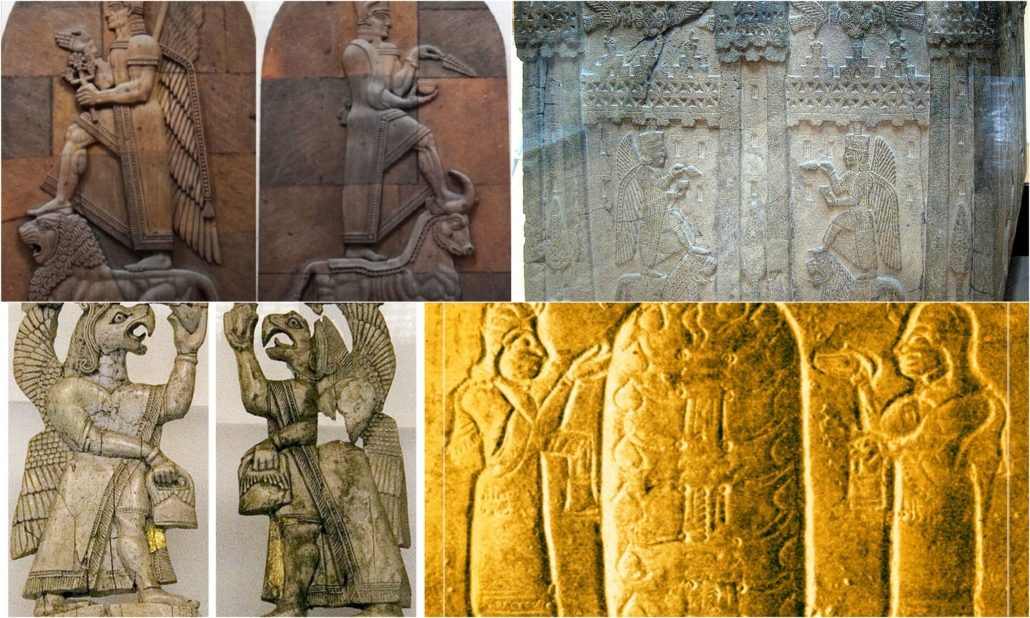
After looking through the art Assyrian art motifs above and below, not similarities between these art pieces and reliefs and biblical scriptures like Ezekiel’s vision which gives some details of what the Cherubim in Solomon’s temple looked like. He says Ezekiel 9-10
“Their faces looked like this: In front a human face, on the right side the face of a lion, on the left the face of an ox, and in back the face of an eagle. So much for the faces. The wings were spread out with the tips of one pair touching the creature on either side” (Ezek 1:10–11)
“the first face was the face of a cherub [or ‘bull‘ see CEV], the second face the face of a man, the third the face of a lion, and the fourth the face of an eagle.” (Ezek 10:14)

In case there’s any question that Ezekiel’s vision is employing exact temple imagery, compare what he says of the cherib’s wings with what is described in the description of the Cherubim in the Holy of Holies of Soloman’s temple, patterned after those on the top of the Ark of the Covenant.

10 …the wings were spread out with the tips of one pair touching the creature on either side… he four creatures looked like a blazing fire, or like fiery torches ” (Ezek 1:9–13)
27 He placed the cherubim inside the innermost room of the temple, with their wings spread out. The wing of one cherub touched one wall, while the wing of the other touched the other wall, and their wings touched each other in the middle of the room. 28 He overlaid the cherubim with gold. (1 Kings 6:27–28)
After more than 200 years in Egypt, the cherub of the Arc as well as those later put on the walls and in the holy of holies of Solomon’s temple were almost certainly adaptations from the sacred iconography of Egypt. For instance, in the temple of Ma’at in Kom Ombo Egypt we see an incredibly similar motif with the Goddess Ma’at acting as a Cherub (in similar style to the faravahar we’ll talk about in a moment) kneeling next to a lion and falcon, each with 6-8 outstretched wings. (note the bull as well).

.
The Palace Garden Scene
Believed to be Assyrian King Ashurbanipal in a scene celebrating the head of the Elamite king Teumman, this scene makes far more sense as a depiction of the events of 2 Samuel 20:3–22 Where David returns to his palace with 10 concubines from the city of Abel Beth Maakah. The preeminent woman is “the wise woman” from verse 14 who saved the city by convincing the people to give General Joab the head of the rebel Sheba (which here is seen hanging in the fir tree). The story is also depicted in midlevel art. Note also that the garland above the king seems to be composed of the same fig leaves and grapes so often associated with David in the bible and artwork in Solomon’s temple.
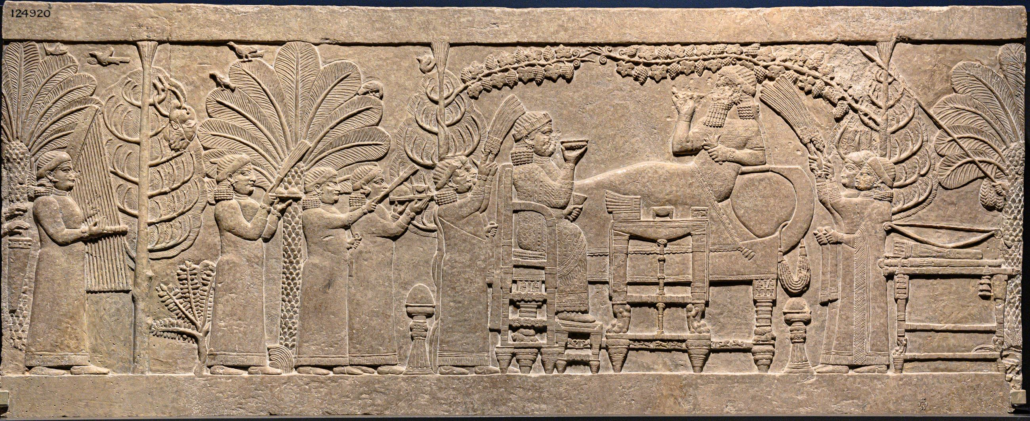
The Kings Library
Jewish tradition (ref) and biblical references (such as 2 Kings 22:8) state that the Jewish temple housed a great library. Is it mere coincidence then that the same palace of Ashurbanipal, housing all these reliefs which so perfectly resemble those of Solomon’s temple and palace, was also the home of the oldest surviving and perhaps most important royal library in Mesopotamia? The library housed up to 22,000 collected tablets in multiple languages. See details here. With perhaps the most complete version of the preeminent Epic of Gilgamesh, which also serves as the foundational mythic tale in the Kolbrin (therein called the story of Hurmanetar)

The Flower Laced Palm Tree
Palm trees held a special place in ancient Israeli religion, being an important part of the Exodus myth, there bing12 wells and 70 palm trees in the first stop after Moses took Israel across the read sea and healed the waters in Exodus 15. Afterwards palm fronds were made to be an important part of the festival of Booths (Lev 23:40–41). Perhaps because of this, combined with the supreme importance of the Date Palm industry in ancient Israel’s economy, Solomon placed cheribum, lions and palm trees on the inner and outer walls of the temple, as well as on the panels covering the wheels of the portable water basins or arcs.
“He engraved cherubim, lions and palm trees on the surfaces of the supports and on the panels, in every available space, with wreaths [לֹיָה, garlands?] all around” (1 Kings 7:36)
More specifically, 2 Chronicles 3:5 says the Cherubim were associated with “palm trees and chains”. And that’s not chains like you’d keep a captive in, but וְשַׁרְשְׁרֽוֹת׃ or decorative jewelry chainwork, sometimes translated as “twisted chain work cordage” (stongs) or translated in NAS Ex 28:14 as filigree. Which if you’re not familiar with a flowered filigree, it’s basically a vine-like floral design. You can see examples here.
As in the picture above, filigrees are often associated with flowers, and those in Solomon’s temple appear to be no different. In 1 Kings 6:29, we see that open flowers were an important part of the chained or garlanded palm trees.
On the walls all around the temple, in both the inner and outer rooms, he carved cherubim, palm trees and open flowers. (1 Kings 6:29)
I’m not sure how to better describe the “Assyrian Trees of Life”, than the bible’s description of the corded/chained palms with open flowers of Solomon’s temple. And these would have been not just on the inside of the temple, but in the “outer rooms”, as well as on the panels of the wagons used for the movable arcs (ref)


In fact this same palm tree garland design is repeated in the two massive brass columns in the front of the temple. These were instructed to have massive lily pedals on top which likely mimicked palm fronds. In 1 Kings 7:15–22 it also states that the capitals or “caps” on the columns were to have “checker-work with wreaths of chain work” likely forming a pattern similar to the palm trees we’ve been talking about.

Ezekiel in his vision, which obviously drew on temple imagery, he adds the detail that these peculiar chained/flowered palms were between two cherubs. Cherubs which in some cases looked like a man and in other cases had the face of lions.
“18 All the walls were decorated with carvings of cherubim, each with two faces, and there was a carving of a palm tree between each of the cherubim. 19 One face, that of a man, looked toward the palm tree on one side. The other face, that of a young lion, looked toward the palm tree on the other side. The figures were carved all along the inside of the Temple, …from the floor to the top of the walls, including the outer wall of the sanctuary…” (Ezek 41:18–20)
25 The doors leading into the sanctuary were decorated with carved cherubim and palm trees, just as on the walls. And there was a wooden roof at the front of the entry room to the Temple. On both sides of the entry room were recessed windows decorated with carved palm trees. (Ezek 41:18–20)
Honestly its hard to see how the world has missed the obvious likelihood that these “Assyrian” reliefs of Ashurbanipal are actually plunder from Solomon’s temple, taken by Nebuchadnezzar II and placed in his palace.

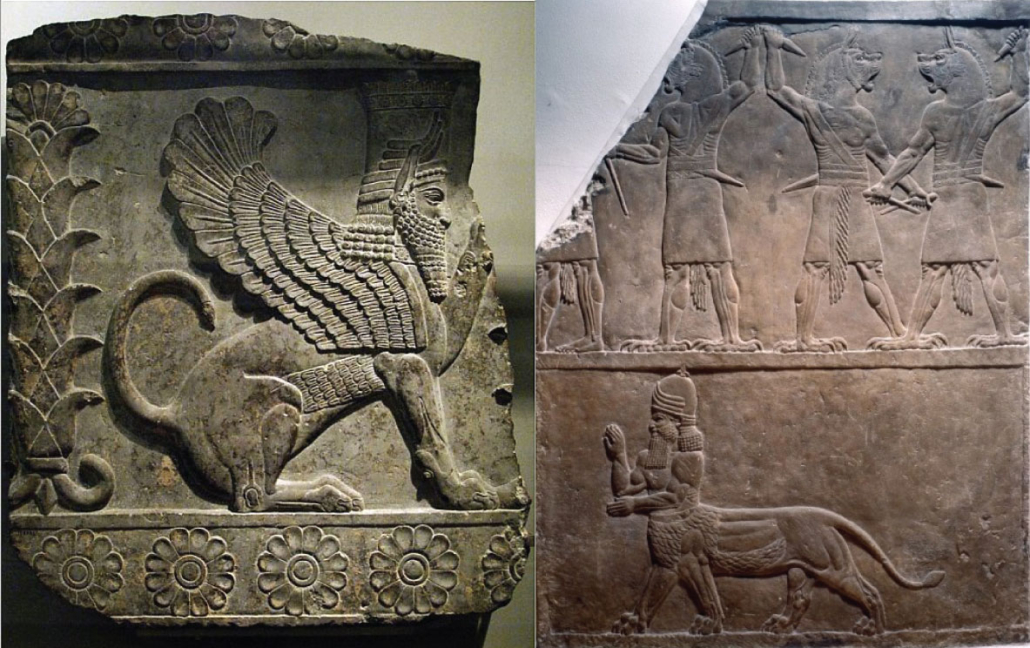
now put a close up of the full cherubim scene… find this high detail. https://www.dreamstime.com/editorial-photo-anunnaki-tree-life-relief-panel-metropolitan-museum-art-manhattan-new-york-ny-ancient-near-eastern-assyrian-royal-image65121271
Pslams give a convincing background for both the lion slaying scenes and the dragon slaying scene. It says.
“3 Surely he will save you… 5 You will not fear the terror of night… For he will command his angels [Seraphim?] concerning you to guard you in all your ways; 13 You will tread on the lion and the cobra; you will trample the great lion and the [dragon]. (Pslams 91:13)
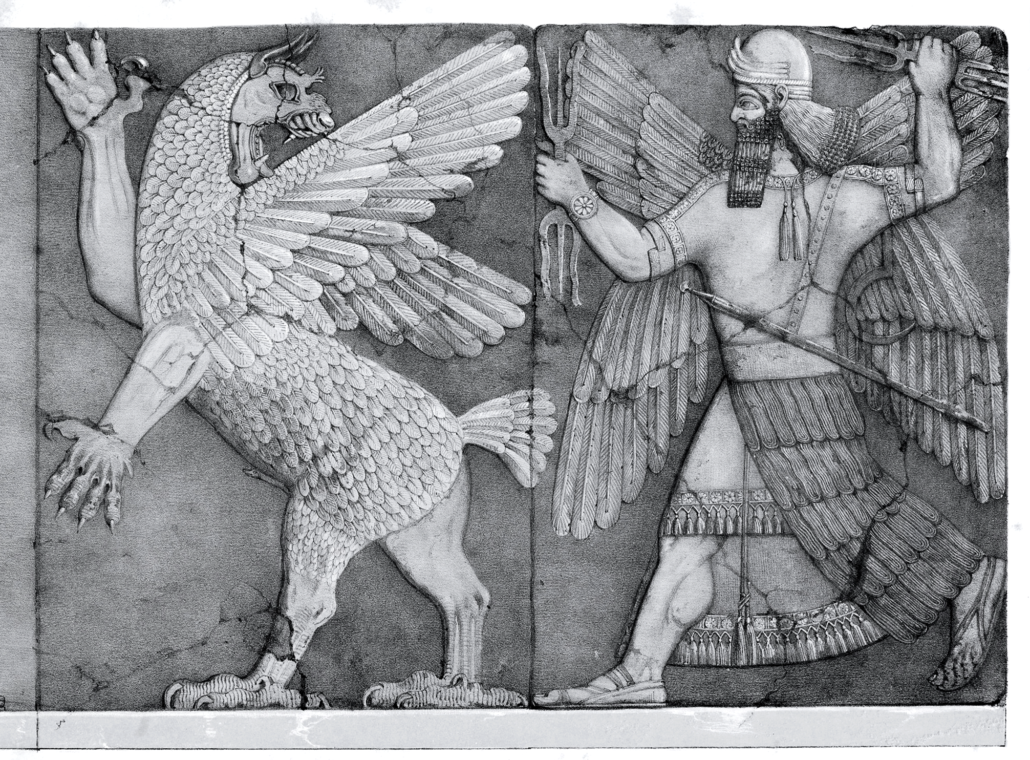
Note also that many of the Cherubim have two sets of wings, or FOUR wings in addition to their arms, just as said in Ezekiel.
Each had… four wings, and under their wings was what looked like human hands [arms]. (Ezek 10:21)
Many of the motifs are combined in this following mural. With so called Assyrian winged genie who are actually biblical cheribum standing before the Tree of Life represented by the chained palm tree (talk about fertility of palm fertilizations), above it are the protective wings of the Lord
5 Also out of the midst thereof came the likeness of four living creatures. And this was their appearance; they had the likeness of a man. 6 And every one had four faces, and every one had four wings. 7 And their feet were straight feet; and the sole of their feet was like the sole of a calf’s foot: and they sparkled like the colour of burnished brass. 8 And they had the hands of a man under their wings on their four sides; and they four had their faces and their wings. 9 Their wings were joined one to another; they turned not when they went; they went every one straight forward. 10 As for the likeness of their faces, they four had the face of a man, and the face of a lion, on the right side: and they four had the face of an ox on the left side; they four also had the face of an eagle. 11 Thus were their faces: and their wings were stretched upward; two wings of every one were joined one to another, and two covered their bodies. (Ezekiel 1:5–11)
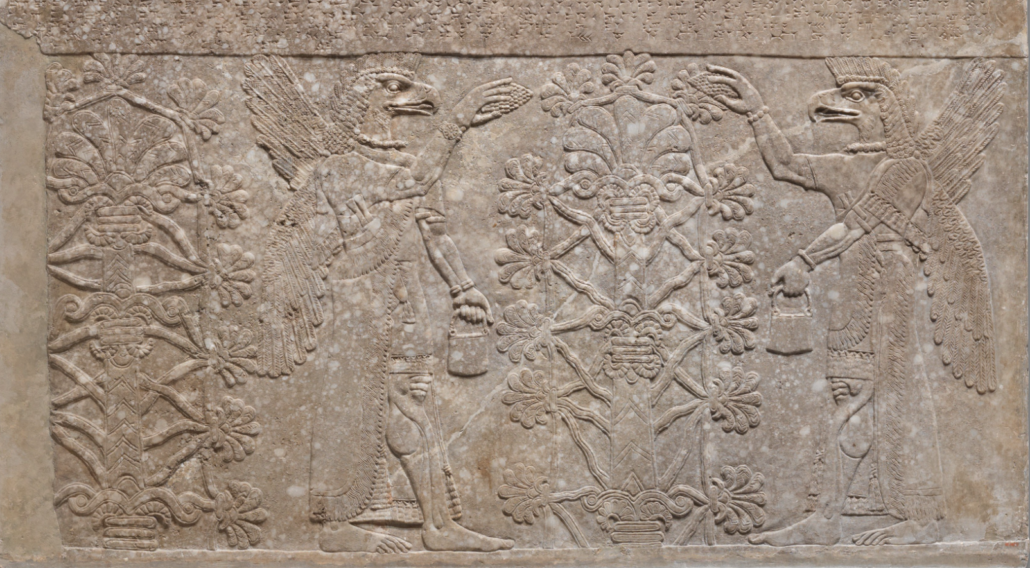
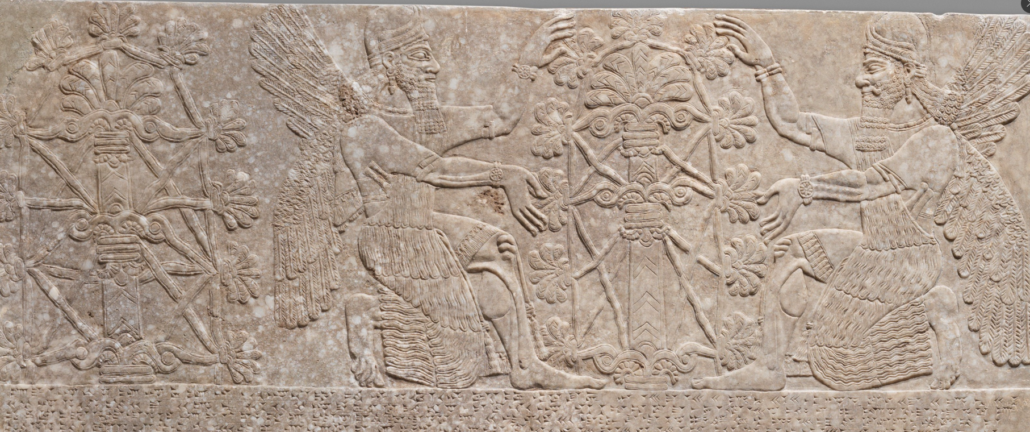
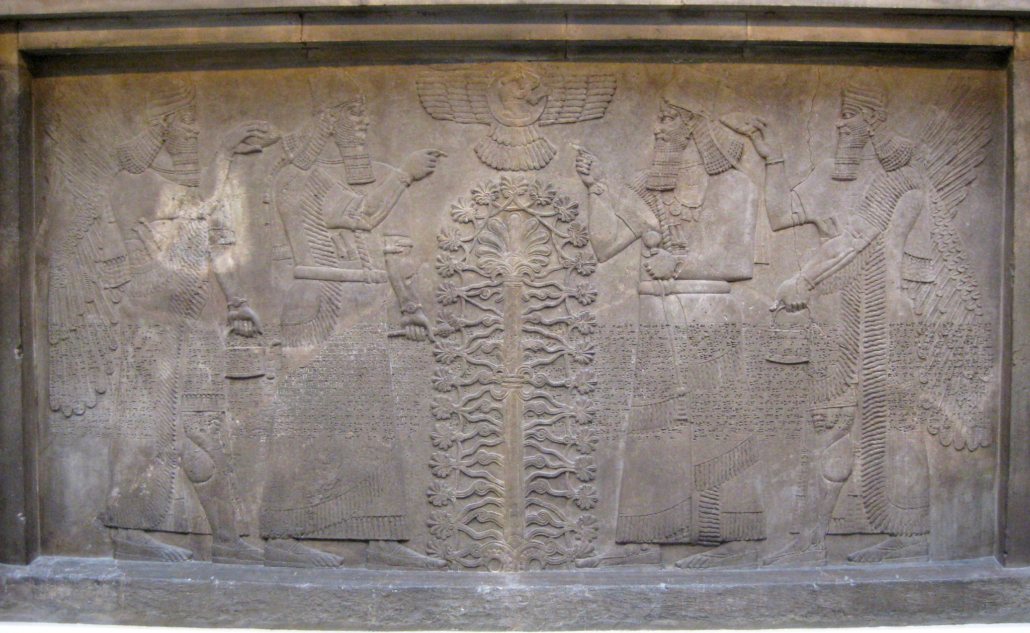

Note that in Isaiah he also utilizes temple motifs in his vision… He sees a beast with 6 wings which may well have been a motif somewhere in the temple, as existing reliefs vary in the number of wings from none, to four in one relief.
Above it stood the seraphims: each one had six wings; with twain he covered his face, and with twain he covered his feet, and with twain he did fly. (Isaiah 6:2)
Talk about the Eagle thing that’s thought to be Persian, and how its found in Darius Wall and in Roman Mithraic temple’s. Understanding its true source in Judaism, helps tie these cultures together, as the Kolbrin shows the jewish roots of Mithra, and Darius, “worshipped the Lord” (ref) and was a follower of … The wings as a symbol of Jehovah in the temple can be seen in the following Psalms
7 In my distress I called to the Lord; I called out to my God. From his temple he heard my voice; 10 He parted the heavens and came down… 11 He mounted the cherubim and flew; he soared on the wings of the wind. (2 Sam 22:7–11)
4 He will cover you with his feathers, and under his wings you will find refuge. (Psalm 91:4)
11 Like an eagle that stirs up its nest and hovers over its young, that spreads its wings to catch them and carries them aloft. 12 The Lord alone led him (Duet 32:11-12)
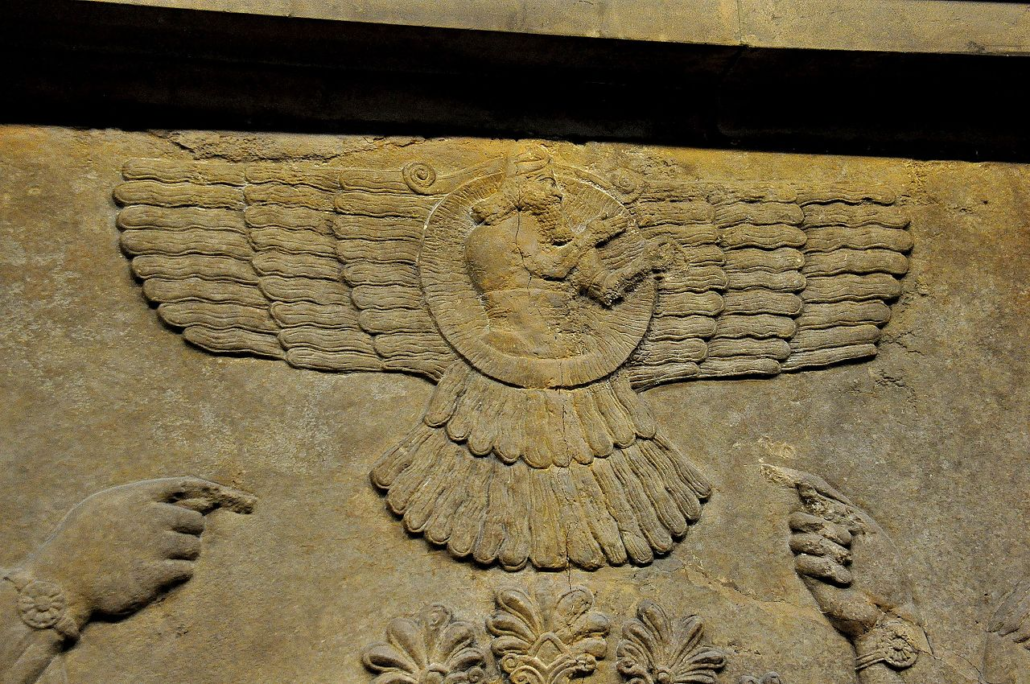
“17 Make an atonement cover of pure gold… 18 And make two cherubim out of hammered gold at the ends of the cover. 19 Make one cherub on one end and the second cherub on the other; make the cherubim of one piece with the cover, at the two ends. 20 The cherubim are to have their wings spread upward, overshadowing the cover with them. The cherubim are to face each other, looking toward the cover. 21 Place the cover on top of the ark and put in the ark the tablets of the covenant law that I will give you. 22 There, above the cover between the two cherubim that are over the ark of the covenant law, I will meet with you and give you all my commands for the Israelites.” (Ex 25:17–22)

Another hint that this was first the national symbol of Israel comes from the famous “Black Obelisk” of Assyria. On its sides, pictures and cuneiform text tell of 31 military campaigns led against five kingdoms conquered by Assyrian king Shalmaneser III (858–824 BC). On it, the symbol is used only in conjunction with Israel’s king Jehu. See more details of this event here.
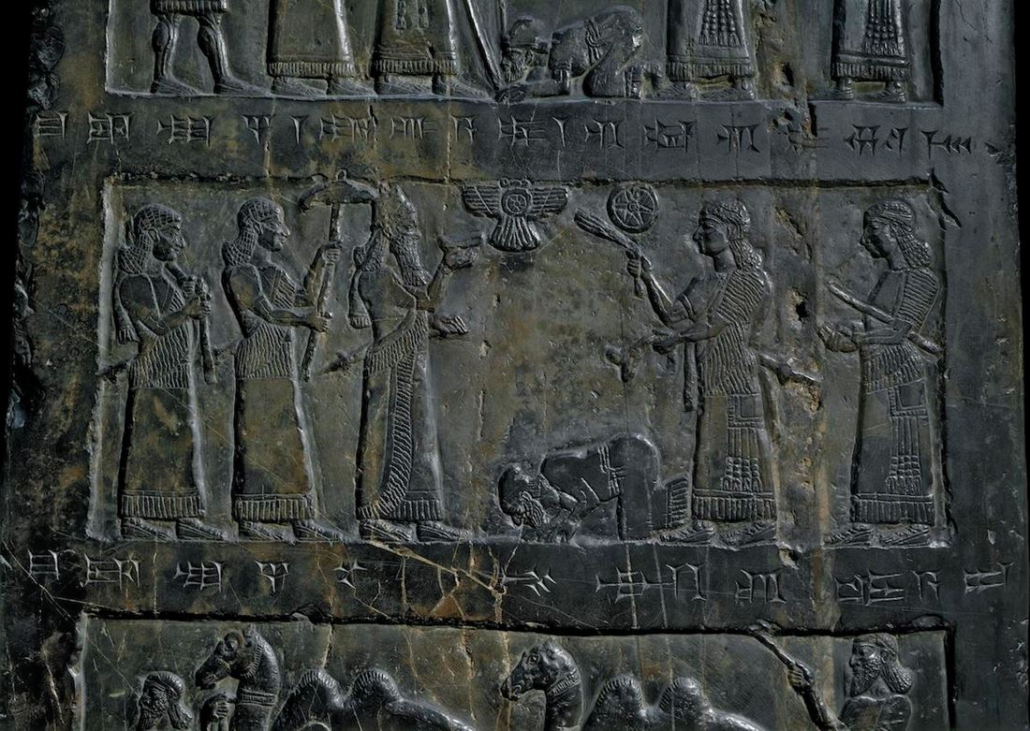
Solidifying the argument that the Faravahar symbol was in fact the National Symbol of Israel is the Hezekiah bulla, found by archaeologist in Jerusalem in the rubble of a building just off the temple mount, destroyed by the Babylonians. Which clearly displays the Faravahar and the Egyptian Anke symbol, which although likely popular religious symbols of Egypt and the greater near-eastern religious culture in general, must have held special prominence for the Jewish
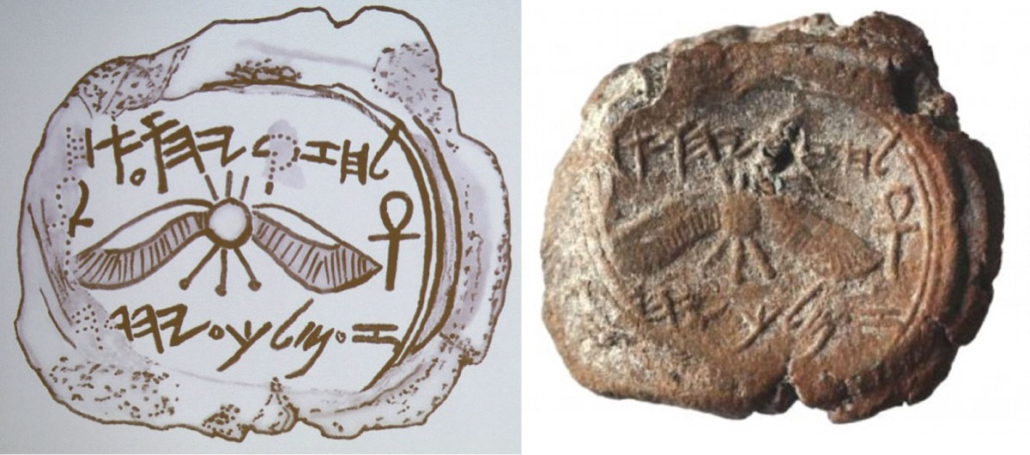
The existence of the “Zoroastrian Faravahar” in association with the Cheribum and Tree of Life is incredibly relevant. As the Kolbrin has MANY stories and sections which seem to tie Zoroastrian Mithraism to early Israeli beliefs. By considering the possibility that Solomon’s Temple is the root and source of the Faravahar, its adoption by Cyrus the Great & Darius actually makes more sense. Darius was a sycophant of Jewish culture and following Isaiah’s prophesy of him by name is said to have sought to spread Israeli belief. Note his promotion of the Jewish Lord God (Jehovah) in the following verses
“26 I decree that everyone throughout my kingdom should tremble with fear [worship] before the God of Daniel. For he is the living God, and he will endure forever. His kingdom will never be destroyed, and his rule will never end. 27 He rescues and saves his people; he performs miraculous signs and wonders in the heavens and on earth. He has rescued Daniel from the power of the lions.” (Daniel 6:26–27)
22 Now in the first year of Cyrus king of Persia, that the word of the Lord by the mouth of Jeremiah might be fulfilled, the Lord stirred up the spirit of Cyrus king of Persia, so that he made a proclamation throughout all his kingdom and also put it in writing: 23 “Thus says Cyrus king of Persia, ‘The Lord, the God of heaven, has given me all the kingdoms of the earth, and he has charged me to build him a house at Jerusalem, which is in Judah. Whoever is among you of all his people, may the Lord his God be with him. Let him go up.’ (2 Chron 36:22-23)
With this understanding, now it makes sense why Darius & Cyrus’ new capital at Persepolis Iran, copies the Assyrian motifs! Not because he was a worshiper of the Assyrian gods or because Assyrians were Zoroastrians, but because Cyrus was a worshiper of David & Solomon’s monotheistic god, Jehovah. He then spread his belief of the Armenian blend of Judaism spoken of in the Kolbrin (which we call Zoroatrianism) throughout his empire by making it the state religion.


The Jerusalem Temple Complex would have been one of the most impressive in the ancient world. Here’s a well done illustration showing the scales of the differing buildings and courtyards laid out in the bible.
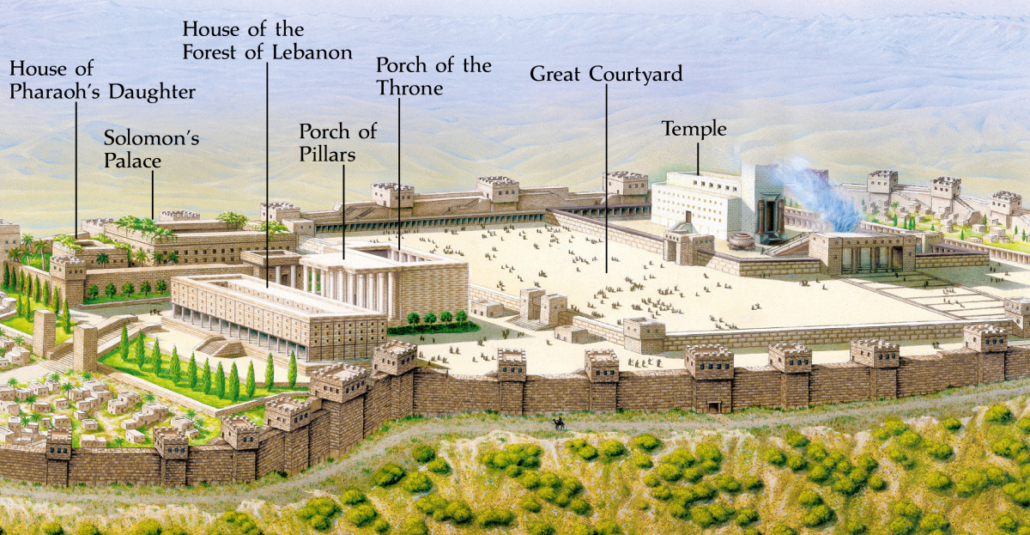
-Add this: This should be obvious from the ‘Assyrian Timber Transportation relief’ of Dur-Sharrukin in the Louvre. Which obviously is another relief stolen from Jerusalem (probably both the temple complex and Solomon’s palace) illustrating the construction of the temple and transport of Cedars of Lebanon used in the temple as described in 2 Chron 2:7-13

The Lion Hunt
The many lion hunt scenes from the Palace of Ashurbanipal also share a connection to Hebrew scripture. Not only would these reliefs explain the cultural nickname given to David and the Southern Kingdom as “the Lion of Judah”, it also … (finish — add some lion hunt scenes)

Kolbrin Temple Rites
The Kolbrin incorporates all these motifs into a secret temple rite which the “sons of light” participated in. (under construction. I’ll finish presenting the evidence here sometime. Also I need to finish adding the animal references below… and the Mithraism stuff — one of the primary reasons is that the priests of Judah would never parade these sacred motifs in front of the world. They would only be IN the temple. With the cherubs of the arc. Note that not only did Solomon place Cheribim over the Arc (1 Kings 6:27), they were on the temple doors (1 Kings 6:32), and all the walls.
“He overlaid the ceiling beams, doorframes, walls and doors of the temple with gold, and he carved cherubim on the walls.” (2 Chronicles 3:7)
“1.1 Herein are recorded sacred things, which should never be written, but the memory of man is like a storehouse made of straw… placing his trust fully in the protecting wings which are spread by the words issuing… 1.7 Look now at the great dark water mirror and see what is reflected there from the mists… 10. Even as it was in the Land of the Great River [Egypt], so let it be here. Let him not be cut off by distance.
1.29 O everlasting Kohar, take this man of goodness… he is the drop returning to the filled pitcher, the leaf returning to the tree [of life] 3.1 wearing white sandals and fine linen… many come bearing cakes of fine meal and barley cakes, large, fat-bodied fish and meats… honeywine in jars… his arm is strong and he issues his commands to the guardians… 3.8 If there be benevolent Life Shadows beyond the protective pale, they may enter…according to the rites of the Sons of Fire, and thus it shall be for those who enter the chambers of stone.
5.2 He has passed through the Wide Hall and through the Narrow Portal… He continues past the Place of Waiting Souls and sees the awaiting Kohars who will unite with the ascending spirits of men. He bears in his hand the Book of Life and glides over the pure pastures, past the bright dividing flame…” 5:4 The ferryman hesitates; he says, “Show me your token, that I may know you have truly passed the tests”… he is not of Earth, neither is he of Heaven. He is at the place where the two meet and intermingle.. He eats the fruit of the [sic] tree… 21.1 Lord of Life and Light, Creator of the Tree of Life, who made the herb and fruit to nourish men and grass to feed the cattle… hear the cry of my spirit! (Kolbrin, Sacred Registers, SCL ch 1-20)Read the rest of the amazing temple rite in the Kolbrin
TODO
-make a map showing every site these reliefs come from and a timeline of the kings which ruled from them AND then the reoccupation of their capitals by BABYLON, research and write out the narrative of how
OUTLINE (to flesh out)
-points us to Hoshkiah coming to Britain from Israel with Sons of Light, who’se timing is dated from references to ‘the scattering’ and ‘going north’. Also Amos is only prophet quoted. Also last reference to Egypt is Akenaten, and also a reference to David being contemporary with Ahmose and the Hysos, which helps us see some likely problems with radiocarbon dates, Egyptian chronology and the bible (which we already suspect)
-Then Hosea, points us to Mesoamerica, with the eagle and the serpent and the 52 weeks.
-Then the temple ceremony account gives us some real evidence that the eagle/falcon, serpent and satchel are closely associated with the Jewish temple ceremony & mysteries.
-Which makes us take a closer look at the Assyrian temple busts and reliefs that illustrate the Eagle, Bull, Lion and Anuku. –Which the dream told me — these are from Solomon’s temple. (something I refused over and over to believe)
-Which leads us to Ezekial and Kings/Chronicles which make it hard to dismiss, these are from Solomon’s temple! (walls were decorated inside and out with Cherubim, palms, flowers and pomegranates (show pics). Ezekial likely details the Cherubim are Eagle, Lion, Bull, face of man. And lots of wheels, just like the reliefs.
(now flesh this out)
The Kolbrin also gives an account of the Israeli sacred temple rites. A ceremony apparently performed to initiate inner circle priests not only in the temple at Jerusalem, but in satellite sanctuaries among the scattered people of Israel. Its not clear whether the same temple rite was used among the Northern Kingdom and Southern Kindom of Judah, but the resemblance of the motifs incorporated in the Kolbrin Temple rite leads us to believe that wall reliefs found in the Assyrian palace at Nimrud and Dur-Sharrukin, actually originated in the Jewish Temple.
This conclusion is not the obvious one, as current archaeological thought dates Sargon II’s temple of Dur-Sharrukin at about 720 BC. This conclusion was reached about the turn of the 20th century based on inscriptions mentioning Sargon. This inscription led to the conclusion that the palace of Dur-Sharrukin belonged to Sargon the Assyrian of the bible and therefore the agreed upon date falling in the Assyrian dynasty.
However, the Kolbrin offers a few details which suggest a reconsideration of this date. Primarily the afore mentioned temple rites of SCL 1-30, in which we see motifs which are so uncannily similar to the depictions in the reliefs of Dur-Sharrukin and Nimrud as to seem impossible a coincidence. Namely, The Tree of Life (SCL:21:1, 21:10, 33:20), A ‘date stone” referring to a date seed, which matches the Assyrian tree of life (SCL:32:4), Falcon or Eagle (ref), Bull ( SCL:1:41, 9:15) and Lion (SCL 33:10) as Cheribim.
-The two most notable places where the genies existed were Ashurnasirpal II’s palace Kalhu and Sargon II’s palace Dur-Sharrukin. (reference)
-Dur-Sharrukin contained a reference to Sargon II. Who sounded like the Sargon of Assyria, so the city was dated to that time. But the truth is, Sargon of Assyria was Sargon of Akkad!, and this reference is just Nebacenzer or someone related using the title. Sargon II, was a ‘cup-bearer’ which sound more like a Nehemiah-like servant, not the king.
-But there has been considerable debate concerning the true names and identity of these two cities. Early archaeologists identified the site with the ancient city of “Larissa” named in Greek historian Xenophon’s book Anabasis. Even today archaeologist find the site’s wall, ziggurat and stelas match perfectly with his description. HOWEVER, Xenophon in Bk. 3 Ch. 4 Verse 12 (and another historian), say the city “was besieged by the king of the Persians at the time when the Persians were seeking to wrest from the Medes their empire.” This equates the city with that sacked by Cyrus the Great (king of the Persians) in 557 BC! (see this amazing reference)
-On top of this, surviving Babylonian letters describing Dur-Sharrukin sound exactly like Nebechadnezzer and his Hanging Gardens (which have never been found), see https://en.wikipedia.org/wiki/Dur-Sharrukin#Description “On the central canal of Sargon’s garden stood a pillared pleasure-pavilion which looked up to a great topographic creation: a man-made Garden Mound. This Mound was planted with cedars and cypresses and was modelled after a foreign landscape” (see wiki)
-These two sites are home to the amazing wall reliefs of the Bull, Lion and Eagles with faces of a man. These motifs match exactly with Ezekiel’s description of the Cheribim of Solomon’s temple in Ezekial 9-10. In chapter nine he sees those who are coming to “execute judgement on the city” (Ezek 9:1–3). Then in an ethereal visionary experience, he sees the Cherubim carried off amidst a whirlwind of wheels and defiled eyes (Ezek 10:1–20). The four cherubim of the temple he describes as “the first face was the face of a cherub [or ‘bull’ see CEV], the second face the face of a man, the third the face of a lion, and the fourth the face of an eagle.” This is EXACTLY the description of the Assyrian wall relief Cheribs of Dur-Sharrukin and “Ninevah!” Why? Because these are not Assyrian capitals but the Babylonian capital of Nebecanezzer!
QUESTIONS TO STILL SOLVE:
-I still need to figure out the significance of these scenes… one is obviously lots of cedars of Lebanon, likely a fig tree in there too. Whats the monument commemorating?
-point out somewhere how the temple was meant to look like a man? Two columns being legs and like Daniel’s dream.
-Is the ‘standard inscription’ written on the panels original? (Some of it yes? Some of it no?) Is it all propaganda and graffiti from Nebuchadnezzar? From Omri? From David or Solomon? (ie. Ashur-nasir-pal II is one of those figures). Answer: Across every relief is similar writing called “the standard inscription.” Read about it here. You need to find the original sources for EVERY Assyrian king list, especially those with Ashur-nasir-pal I or II, and find out if its possible the floating chronologies are arrange wrong and Ashur-nasir-pal is earlier or later. (Note Ashur has Semitic origins, Ashur-dan is an especially biblical sounding king name with both parts one of the ’12 tribes’.)
-Is the library entirely from the temple, or a mixture of sources? Are the tablets originals, or did Daniel and the Jewish scribes transcribe them all into Babylonian cuneiform?
-Does Nebuchadnezzar’s madness match whats said in the Kolbrin of the unworthy attempting to be twice born? Is this why his successor abandoned it? Did he burry the palace too?
-Is Sargon the Great David and Hammurabi Solomon? Does much of our info on them come from the library?
-Many of these questions can be answered by reading the cuneiform chronicles of Assyria & Babylon, available at livius.org
-some of the best pictures (easy to screen capture): https://www.metmuseum.org/toah/hd/nimr_2/hd_nimr_2.htm
-British museum has virtual tours, here and here. Others can be googled.
-see also the Louve’s site.
After writing this article, I found this youtube article with a great overview of the pale and cone motif. Mystery of the Sumerian Handbags SOLVED – YouTube

